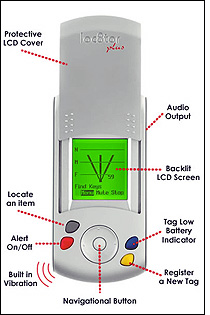While businesses and governments hope RFID can help them solve major supply chain efficiency problems, some companies are thinking up new ways RFID can simply make consumers’ lives easier and more convenient. Loc8tor, a U.K.-based startup, is one such firm.
Loc8tor developed a handheld RFID system designed to save consumers the frustration of losing keys, cell phones or other important but easily mislaid possessions. The tags can also be used to track people, such as children or elderly companions, who might wander off. Some users attach the Loc8tor tags to their pets. The tags can be attached to goods via an adhesive strip, or carried on a key-ring loop. The Loc8tor interrogator and tags operate at 2.45 GHz, using a proprietary air-interface protocol. The tags have a read range of up to 600 feet in open air.
The Loc8tor product, manufactured in the United Kingdom, debuted in 2006 and garnered attention by being nominated as innovation of the year in the “best new personal electronic” category at the Consumer Electronics Show in Las Vegas. Time magazine also named it one of the best innovations in 2006. Today, says Loc8tor spokesperson Vicky Lewko, roughly 60 percent of orders for the product come from consumers in the United States. The remaining 40 percent, she claims, are from the United Kingdom and 28 other countries. Loc8tor’s base of users is quite diverse: “Everyone from mothers looking to track cell phones, to elderly people looking for important drugs or wanting to keep track of their eyeglass cases,” says Lewko, who won’t reveal how many such devices the company has sold to date.
A model airplane hobbyist in England attaches the Loc8tor tags to planes so he can find them more easily when they land in brush. And a U.S. user who says the system helps him find his cats more quickly has posted a YouTube video to prove it.
The handheld interrogator can be set to seek out up to 24 tags, each of which the user can name with up to 10 characters, describing to what or whom the tags are attached. The tags can be set to broadcast an alert whenever a tag reaches a certain distance from the reader. When the handheld is set to the locate mode, the user selects a tagged item saved in the handheld’s database, then initiates a search for that tag. Once the interrogator finds the desired tag’s signal, it emits a low, slow beep and three lines appear on the handheld screen, while the tag begins emitting a low, constant audio signal and flashes an integrated LED.
The manufacturer suggests that once this happens, the user should hold the interrogator—which can measure the strength of the signal it has detected—and slowly turn 360 degrees. When the device is facing the direction of the tag, the signal strength increases. In response, the lines grow longer and the beeping becomes faster. As it nears the tag, the lines grow longer and the beep increases in frequency, until it is within 1 inch of the tag.
When the handheld is set to the alert mode, it constantly interrogates whatever tag the user wants to monitor. The user selects a near (approximately 20 to 100 feet), medium (100 to 300 feet) or far (300 feet or more) safety zone for each tag. Once the interrogator determines, based on the tag’s signal strength, that it has moved beyond its safety zone, it alerts the user through an audible alarm and by vibrating. The user can then set the handheld to the locate mode and track the tag’s location.
There are two types of Loc8tor tags: the homing tag and the panic tag. Both can be used in either application described above, though the panic tag is made for people—especially children or the elderly—who can press an integrated panic button if they find themselves in an unsafe situation and need assistance. After pressing the panic button, the person holding the reader sees the name of the person assigned to the tag. The reader then guides the user to that person. Both homing and panic tags are the same size: 30.5mm x 19.5mm x 8.5mm.
Loc8tor is sold in two packages. The basic Loc8tor package sells for $99.99 and comes with an interrogator that functions only in the locate mode (it does not support alert mode) and comes with two homing tags. The Loc8tor Plus package sells for $170, supports the alert mode and comes with three homing tags and one panic tag. Either tag type can be purchased separately, selling for $45 apiece. Lewko says the company is currently seeking U.S. distributors, and that the products are available in select stores in the United Kingdom. Currently, most the readers and tags are sold through the Loc8tor site.
The concept behind the Loc8tor system is not a new one. Remote Play sells a portable RFID interrogator that sounds an alarm if the user strays too far from tagged personal affects (see RFID Keeps Objects, Kids From Going Astray), and a number of other firms are selling similar systems aimed at helping parents track the whereabouts of small children through the use of tags worn by the children. Unlike Remote Play, however, which operates at 900 MHz, the Loc8tor interrogator enables users to home in on the location of a tagged item, person or pet through audio and visual indicators.
RF Technologies, a provider of asset- and patient-tracking systems for health-care applications, sells a system similar to Loc8tor. Dubbed the Seeker, this system operates in the 433 MHz band rather than 2.45 GHz.. RF Technologies markets the Seeker for asset-tracking applications in the commercial sector, mainly health care (see RFID Platform Plays Marco Polo to Find Assets).


